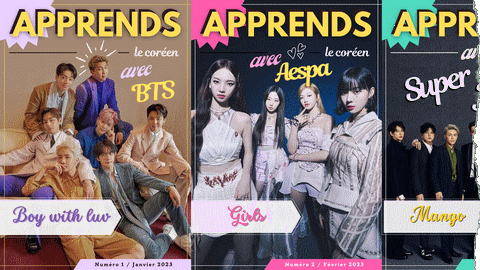Cours de coréen ᚛ Level 1 - My First Steps in Korean (Lessons 1 to 30) ᚛ Leçon 14 - Conjugation of present tense verbs in Korean [-아/어(요)]
Conjugation of present tense verbs in Korean [-아/어(요)]
Currently, the sentences you understand in Korean are limited because we do not yet know how to conjugate verbs. In this lesson, we will see the conjugation of verbs of the present in Korean with the casual and polite styles.
Present Casual Style in Korean
Conjugating verbs in the present in the casual style is simple, but it is necessary to distinguish two cases:
- verbs with a final stem syllable that contains ㅏ or ㅗ.
- verbs with a last stem syllable that does not containㅏ or ㅗ.
Stem in ㅏ / ㅗ
Verbs whose last stem syllable contains ㅏ or ㅗ are conjugated as follows:
[Stem]아
Examples
The verb 살다 (= to live) has a stem 살 which contains a ㅏ, so we add 아 to the stem.
- 살다 → 살아. = I live. / You live. / He lives… etc.
The verb 놀다 (= to play) has a stem 놀 which contains a ㅗ, so we add 아 to the stem.
- 놀다 → 놀아. = I play. / You play. / He plays… etc.
The other stems
If the stem of a verb does not end in a syllable containing ㅏ or ㅗ, we conjugate this verb as follows:
[Stem]어
The verb 먹다 (= to eat) has a stem 먹 which contains neither ㅏ nor ㅗ, so we add 어 to the stem.
- 먹다 → 먹어. = I eat. / You eat. / He eats… etc.
The verb 만들다 (= to make) has a stem 만들 whose last syllable contains neither ㅏ nor ㅗ, so we add 어 to the stem.
- 만들다 → 만들어. = I make / You make. / He makes… etc.
Present Polite Style in Korean
Conjugating verbs in the present tense in the polite style requires taking the form of the casual style and adding the polite suffix 요 to it, as follows:
[Verb conjugated in the present casual style]요
The verb 알다 (= to know) has a stem 알 which contains a ㅏ, so we add 아 to the stem to obtain its casual style form which is 알아. Its polite style form is created by adding the polite suffix 요.
- 알다 → 알아요. = I know. / You know. / He knows… etc.
The verb 읽다 (= to read) has a stem 읽 which contains neither ㅏ nor ㅗ, so we add 어 to the stem to obtain its casual style form which is 읽어. Its polite style form is created by adding the polite suffix 요.
- 읽다 → 읽어요. = I read. / You read. / He reads… etc.
Summary table of structure
En savoir +
Exercises
En savoir +
Apprends le coréen avec la K-pop est un ensemble de 4 numéros qui permettent d'apprendre de nombreux points de la langue coréenne en se basant sur des chansons coréennes récentes. Pourquoi apprendre le coréen avec des chansons ?
- Pour apprendre du vocabulaire et des expressions dans l'air du temps, utiles dans la vie quotidienne
- Pour pouvoir travailler la prononciation du coréen à l'aide de la chanson étudiée
- Pour voir ou revoir de nombreux points de grammaire disséminés dans les couplets
- Pour s'amuser tout en apprenant des choses, car quoi de plus ludique que nos chansons préférées ?
En savoir +


